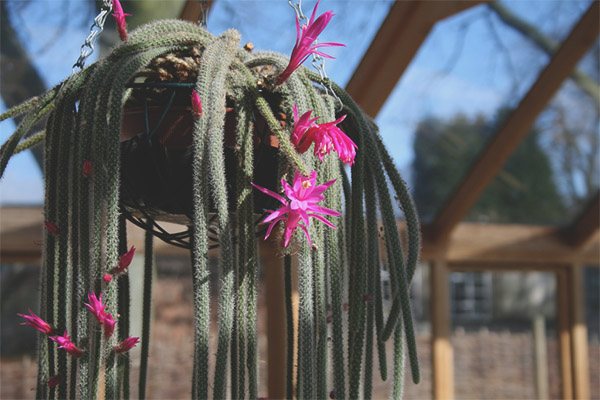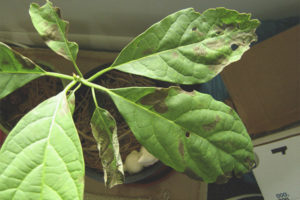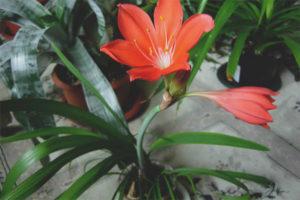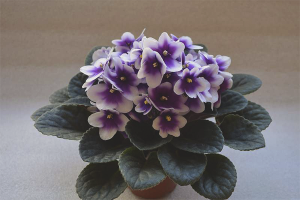The content of the article
Once, aporocactus could be found only in Mexico on stony slopes or in the midst of a pile of bare rocky stones, on branches of trees and shrubs. But thanks to its unusual appearance and unpretentiousness of the plant, you can see it among fans of cacti on the windowsills and glazed balconies in pots.
This species is quite easy to distinguish from other representatives of cacti along fleshy bright green, almost meter-long stems, which, reaching adulthood, hang down like lashes. Their surfaces are covered with small spines.
By the color of the stem you can determine the age of the plant:
- young - has shades of light green;
- the more solid is darker, and over time it acquires a gray patina.
Decorate the plant crimson or pink flowers, looking up.They bloom in spring or summer. It has aporocactus and its own fruit. It represents a berry, wrapped with soft bristles, of red color and rounded shape.
Caring care by certain rules
Florists allocate five species of this species of cacti, and each willingly bred at home.
A place
From the location of the plant depends on how it will grow, bloom, and, therefore, delight their owners. Aporocactus loves a large amount of light, but fears to be in direct sunlight. Professionals advise to keep the plant on the windows located on the eastern or western part of the room - these are the most favorable zones. If there is no way out, and the cactus is on the south side, it is necessary to create an artificial shadow, diffused lighting in the hottest hours.
In cold weather, the plant does not require additional lighting. However, when the formation of buds begins to occur, the light will need more, because you need to move the pot closer to the window. Only if the aporocactus receives a lot of sunlight, the budding will be good, and it will bloom profusely.
Important! A short daylight day is required to be extended with additional artificial lighting.
Temperature
The temperature regime for this plant is also very important:
- In the spring and summer, you should adhere to 20 - 25 degrees of heat, preferably in the open air, but hide from direct sunlight.
- In late autumn and winter, the plant requires complete rest, and it is quite satisfied with the temperature from 8 to 10 degrees of the body.
As for the humidity of the room in which the plant is located, then for him it is not so significant. Dry air and central heating do not frighten the plant. In warm weather, aporocactus can be periodically sprayed, but this procedure is not required in winter.
Watering
Watering is required by all plants, and aporocactus is no exception, but there are some peculiarities.
- When the autumn-winter period comes, watering occurs only when the earth lump becomes completely dry. Some flower growers believe that, since mid-autumn and until the growing season begins, it is impossible even to moisten the soil.
- Starting from the spring season, you need to make sure that the soil in the pot is always wet.When active growth begins, it should also be watered quite often, but make sure that too much moisture does not accumulate. Soil should only be wet.
- Water for irrigation must be defended, it must be sufficiently soft. Many cactus lovers are trying to accumulate rainwater, considering it the best.
- Do not water the plant with very cold water.
Soil and soil, top dressing
The soil of the aporocactus prefers a certain sod, leaf soil, peat, and sand (preferably river water) taken in equal proportions. But there is another option - so ready composition, the substrate, made specifically for cacti. You can buy it in any flower shop. It is desirable to add a small amount of small pebbles to the finished soil.
In order for the plant to be in comfortable conditions, the ground should be loose, it should be perfectly watery, with a drainage layer, and the pH of the soil should be neutral or slightly acidic.
It requires aporocactus periodic feeding, starting in the spring and until mid-autumn. In winter, it is not necessary. It is enough to add fertilizers only once a month, and after flowering this procedure is not recommended.
Transplanting should be beneficial!
This plant has a very weak root system, and therefore for planting it is best to choose pots with small holes, shallow depth, but in diameter they should be wide enough.
Young plants are usually transplanted, and this will be required every year. Adult aporocactus is subjected to such a procedure once every three years when the need arose, that is, when the roots have already filled the entire space. So as not to damage the weak roots, they are transplanted along with the earthy clod, being careful.
It is advisable to transplant the plant after purchase, completely replacing the soil, as it is usually found in a flower shop in a special shipping container that is not suitable for cultivation.
Procreation
This cactus can breed not only by cuttings, but also with the help of seeds. To continue the race using cuttings, you should:
- Cut the long stem into pieces that correspond to 7-8 cm and dry them for 7 days. Some flower growers are advised to cut parts only from the top of the shoots.
- Each part is placed in prepared sandy peat soil, covered with glass, creating a temperature regime of 20 - 22 degrees of heat, and light - at least 10 hours.
- When the cuttings gain a little strength, they will strengthen, they will need separate pots.
Reproduction using seeds - the procedure is very difficult, because at home it is not easy to implement. Usually, specialists in the botanical garden are engaged in this, having available equipment and conditions.
Malicious insects and dangerous diseases
This beautiful, but very gentle plant has enemies. First of all:
- Shchitovka. Immediately visible on the wax shield. Juveniles move actively, the rest are immobile. Piercing the stem, the pest sucks the juice. On the surface of the plant remains a sticky liquid, it turns yellow. It is usually treated with a soap solution, if there are too many parasites, chemicals are used.
- Spider mite It feeds on plant sap. Its presence can be identified by the appearance of dry yellow spots and thin whitish webs. Treat with insecticides.
- Nematode. In fact, a microscopic worm that is common in a humid environment. The danger is that it releases toxic substances by clogging up tissues. Most often, the plant can not be saved.
If watering occurs in large quantities or the temperature in the room is very low, fungal disease can begin. The most common is root rot. It is dangerous because it is almost impossible to detect it at once, because the condition of the stem at the base must be periodically checked. It is hard to fight rot, but it is possible to save the plant. It will be necessary to cut the already affected stems, and process the remaining and cut sites with fungicides and charcoal that have been pounded beforehand.
If a plant suddenly starts to lose flowers - most likely, it lacks moisture or top dressing.
Plant species
The varieties of aporocactus are very beautiful:
- Kontsatti has a long stalk of rich green color with clearly marked ribs, covered with yellow or light brown spines and decorated with large dark red flowers. At will grows near the sea.
- "Martius". It has large dark pink flowers, long stems with indistinctly pronounced ribs, the surface is covered with small spines, the color of which is gray. In nature, you can meet in the highlands.
- "Weave". It is considered the most unpretentious.The main difference from other species is that it has many hanging shoots not more than 1.5 cm thick, covered with small yellow-brown spiny bristles. When the plant is very young, the stems grow up, and only with time they begin to fall. The flowers are pink, and the fruit is a round red berry, which also has small bristles on the surface. It blooms for a short time, and when the flower dries, fruits appear on this place.
Video: Care of the Apococactus












To send